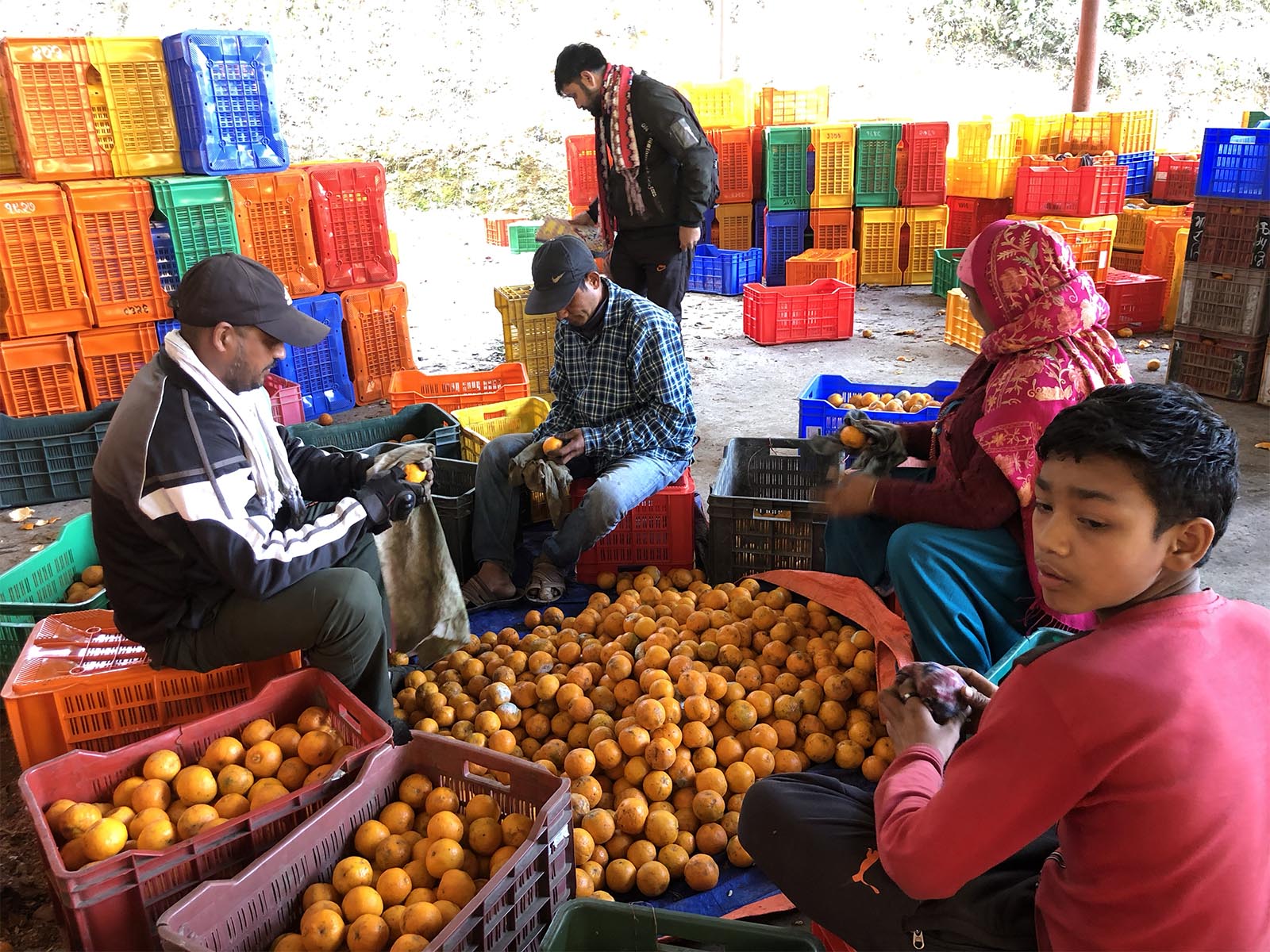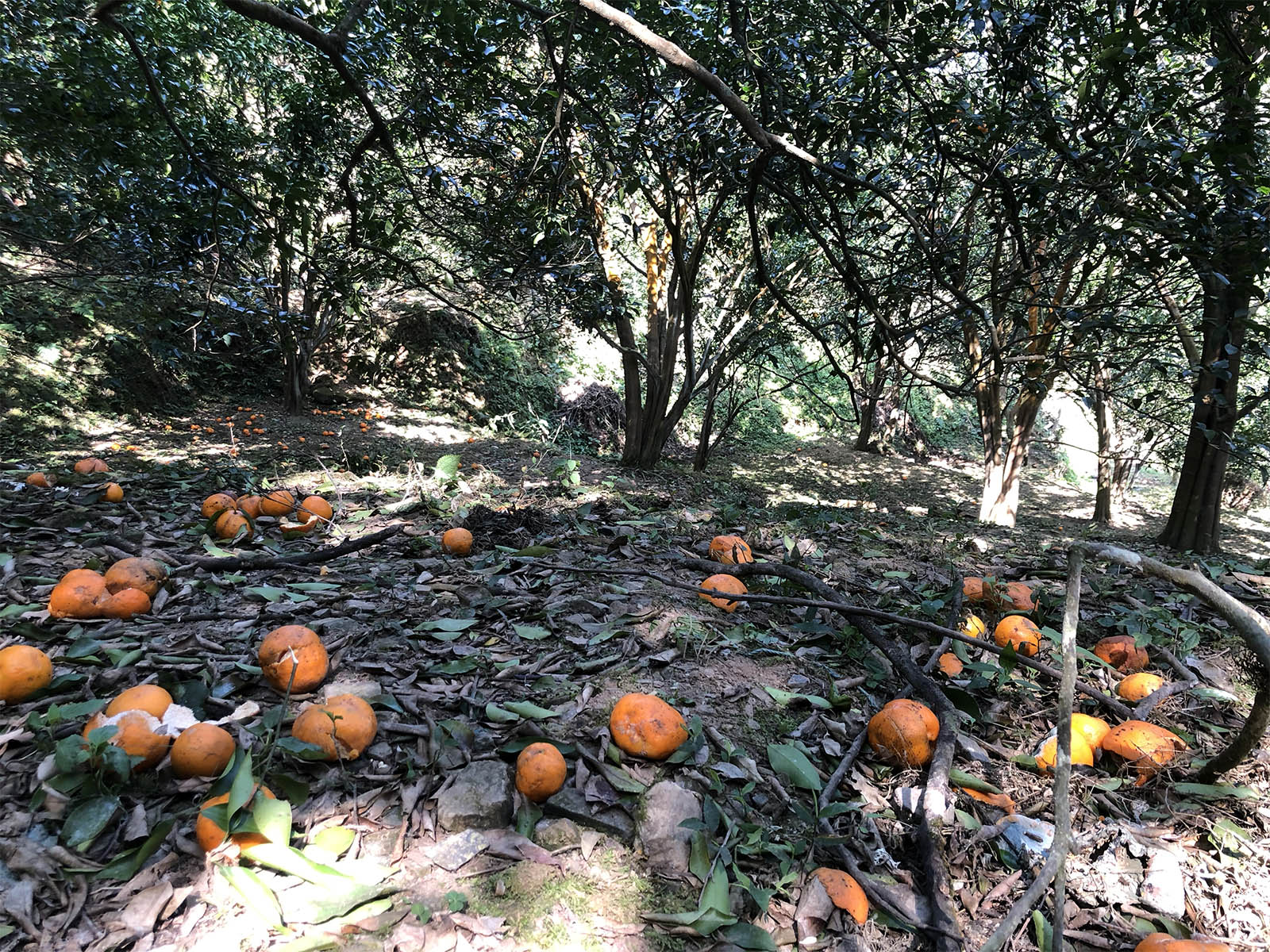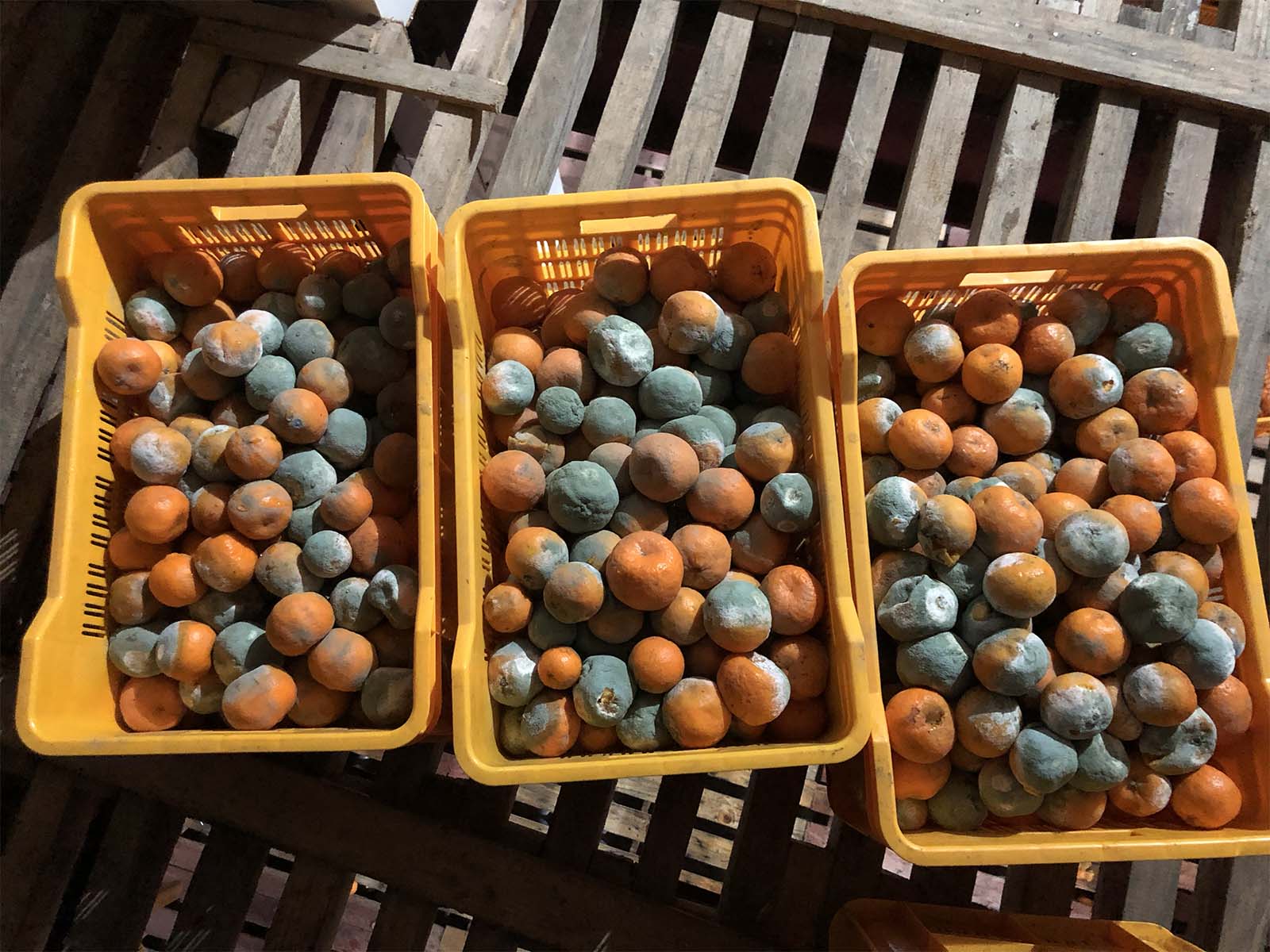Spoilage loss inhibits plan to buttress value chain of mandarin oranges in Syangja.
Dinesh Kafle |CIJ, Nepal
It rained suntalas in Syangja this winter. The monsoon had been benevolent and hailstones a rarity. By the time Dashain and Tihar were over, the mandarin orange tree branches were bowing down with the weight of their produce.
Traders from Kathmandu, Pokhara, Butwal and Narayanghat began to visit the mandarin groves and place wholesale prices on the mandarins. Over a hundred farmers were estimated to have made more than Rs1 million each, while a few crossed the Rs4 million mark.
But Dil Bahadur Rana, 40, a mandarin farmer and trader, had different plans. He has between 600 and 700 mandarin trees in his ancestral grove in Thuladihi, in Putalibazar Municipality-7, out of which between 120 and 130 bear fruit, totalling around 8 tonnes.
Rana knew that higher yield meant greater supply and lower prices, especially when everyone was selling at the same time. So he bought mandarins in bulk from his neighbours and prepared to wait.
Rana plucked the first lot in the last week of November when the mandarins were moderately ripe and transported them to the cold store at Jaisidanda, 7 km from the Syangja district headquarters.

According to the Agriculture Ministry, Nepali farmers grew 198,406 tonnes of mandarins in 2020-21. Photos: Dinesh Kafle
By December 24, when he deposited his last batch in the cold storage warehouse, he had hoarded around 25.6 tonnes. He then went home to spend time with his family, tend to the pigs, and deliver heaps of manure to the mandarin trees to prepare for the next bloom. He planned to return two months later, when mandarins would be in short supply in the market, to sell his stock.
Two weeks later, Rana got an urgent call from the cold store. He was numbed by what he saw there.
“More than half of my stock had rotted,” Rana told the Post.
Rana wasn’t the only one who lost his mandarins. Nearly 50 percent of the 126 tonnes in the cold store was lost to mould; the rest had to be sold off at reduced rates owing to imminent decay.
The cold store is just one in a network of support infrastructure necessary to turn Syangja into a “mandarin orange superzone” as part of the government’s Rs130 billion Prime Minister’s Agriculture Modernisation Project. Launched in 2016, the 10-year project identifies the feasibility of promoting specific agricultural vocations in various districts, and helps develop them into pockets, blocks, zones and superzones.
But the cold store’s failure showcases the numerous gaps in Syangja’s post-harvest produce management practice.
Grown widely in the mid-hills of Nepal, between 800 and 2,400 metres above sea level, mandarin—Citrus reticulata Blanco or suntala, as it’s locally known—contributes 0.85 percent to Nepal’s agricultural gross domestic product.
According to the Ministry of Agriculture and Livestock Development, Nepali farmers grew 198,406 tonnes of mandarins on 18,369 hectares in the fiscal year 2020-21. In Syangja alone, production reached 18,350 tonnes on 1,225 hectares of production area.
A citrus fruit whose roots are traced to China, mandarin has been a major cash crop among farmers in Syangja ever since its vocational plantation began almost 50 years ago, with farmers in the Jaisidanda, Rangkhola, and Mayatari areas taking the lead.
“In 1973, I planted three saplings that I received from the then District Agriculture Office,” said Krishna Aryal, a pioneering mandarin farmer in the district who says he now has 1,200 mandarin trees. “In 1977, I harvested a doko basketful of mandarins. This year, I made around Rs3.6 million.”
This year, the district harvested 22,000 tonnes of mandarins, worth around Rs1.38 billion, according to Binod Hamal, chief of the Agriculture Knowledge Centre, Syangja, a provincial undertaking to modernise agriculture.
The district also holds the distinction of having the largest density of mandarin farming in the country, one of the reasons why the government, in the year 2016-17, declared the district a “mandarin superzone”.
The superzone area accommodates over 3,000 farmers in the district, and covers over 2,000 hectares of land.
According to Tuk Bahadur Thapa, an agriculture officer at the Project Implementation Unit in Syangja, there are around 1.2 million mandarin trees in the district, and this is a conservative estimate.
The Syangja superzone office, which has helped increase the district’s mandarin acreage by 700 hectares in the past six years, aims to increase it to 3,000 hectares in the next four years when the project ends, according to Madhav Lamsal, chief of the implementation unit.
To this end, it provides farmers with technical support and a 50-85 percent subsidy to purchase harvesting materials, including clippers, crates and bags.
“There has been a wave of mandarin cultivation in the district after the superzone office was established,” Thapa said. “Farmers come to us saying they have cleared their jungles, and want to plant mandarins and that they want our support.”
Mukti Adhikari, 48, a farmer from Putalibazar-10, Rangkhola, exemplifies this growing interest. Adhikari spent 15 years in South Korea, mostly doing what he says was a “3D” job: dirty, difficult and dangerous.
He returned home 10 years ago after his father fell ill. His father died soon after. Adhikari did not return to Korea, but decided to tend to the mandarin grove his father had developed 50 years ago.
“I was born and brought up on the mandarin grove,” Adhikari told the Post in January as he helped his workers adjust a huge tarpaulin sheet placed below the tree branches to keep the fruits off the ground.
“If you have 5 ropanis (2,500 square metres) in Syangja facing northeast, you should become a mandarin farmer rather than chase a government job,” said Adhikari, who claims to have made an estimated Rs4.5 million from mandarin sales this winter.
He says he has around 500 fruiting trees and has planted an additional 1,700 saplings recently.
But the cold store has him worried. This year, all but 4.5 tonnes of the 12.3 tonnes of mandarins he had deposited there rotted. Adhikari, also a member of the cold store management board, says the government should have been more forthcoming in its support to the farmers.
The eye of the storm
The Syangja Cold Store Cooperative Committee was established in 2012 with the sole aim of establishing a refrigerated warehouse to minimise post-harvest losses and maximise farmers’ profits. Initially, it allowed farmers to store their mandarins for free as a trial phase. The spoilage loss last year was around 10 percent.
This time, the cold store planned to charge them Rs120 per crate of 20 kg for three months, but decided not to charge any fee after the mandarins rotted. The Project Implementation Unit paid the electricity bill, charging the farmers a reduced fee.

The warehouse, the size of around a dozen trucks, is nestled on a hillside in a sinyaale, a shadowy corner, 100 metres below the Siddhartha Highway. Commonly known as Chisyan Kendra, the cold storage was established in 2012 and is supported by 104 cooperatives and three municipalities—Putalibazar, Galyang and Bhirkot.
The initial plan was to build a cold store with a capacity of 2,500 tonnes at a cost of Rs240 million, with a 60 percent grant from the Department of Cooperatives.
According to Ananta Kumar Shrestha, chairperson of the cold store, they raised the rest of the money from other sources, including a Rs20 million loan from the National Cooperatives Development Board.
With the opening of the facility, farmers had hoped that they would be able to sell more of their fruit until the start of the summer, earning more and throwing out less. But that was not to be.
In the last week of January, a dozen men and women sat on the porch of the cold storage warehouse, sorting a heap of mandarins in various stages of degeneration. The fully deformed mandarins went into one set of crates to be dumped on a terrace just a kanlo below the porch, to keep the sight and smell away.
Relatively fresh ones were sorted by size—jethi in one, maili in another, and kanchhi in yet another—to be sold to middlemen for Rs100, Rs80 and Rs50 a kilo, respectively.
Those laced with moderately green mould were wiped with a cotton cloth and placed into a separate crate for sale at half price.
Amid the chatting workers, Dil Bahadur Rana too was sorting the mandarins pensively.
“They should not have tampered with the temperature,” Rana said. “I lost only 10 percent when the temperature was set at 5.5 degrees Celsius. Things got worse when they hiked it to 10 degrees.”
Ills begin at the grove
Rana believes that the mandarins went bad due to the temperature hike, but others are not so sure.
Umesh Kumar Acharya, chief of the National Citrus Research Programme in Dhankuta, says the temperature was not the only problem. He was one of the scientists called for help after the operators realised the infection was getting out of hand.

Oranges rotting at cold storage in Jaisidanda, Syangja.
Acharya’s team found that the temperature was maintained at 5.5 degrees Celsius, which was too cold for the mandarins, leading to chilling injuries.
He suggested a temperature of 8-12 degrees Celsius and a relative humidity of 85 percent, not the 75 percent maintained at the time of his team’s visit.
But Acharya says he found even worse problems. The door of the facility was kept open, and individuals coming with even one crate were allowed in, disrupting the airflow and the controlled temperature.
Many of the mandarins were too small or damaged and were unfit for long-term storage.
“Blue and green mould are common occurrences in stored mandarins. The idea is to disinfect them with water and calcium chloride before storing them, which they didn’t do,” he said.
For Acharya, the problems began right at the farm due to haphazard harvesting methods. “The farmers did not follow standard operating protocol during and after harvesting the fruit,” he told the Post.
Fruits aimed for long-term storage need to be treated differently. The mandarins must be picked half-green using gloves and fruit clippers during the daytime when there is no dew.
Once plucked, they must be washed with a water and calcium chloride mixture and left to dry in the shade. Then, they must be stored in the cold room using sanitised crates—all within 24 hours of harvest.
Shrestha, the cold store chairperson, concedes that they failed to enforce strict protocol. “Some farmers brought their mandarins in sacks, but we did not want to send them back as they would feel discouraged. It was a mistake,” Shrestha admitted.
Asmita Khanal, a horticulture scientist at the National Agricultural Research Centre in Malepatan, Pokhara, another expert invited for observation, agrees with both Acharya and Shrestha.
“Last year, the farmers followed protocol, as there were fewer of them, and the protocol was easier to enforce. This year, though, the cold store operators ignored protocol as they got an unexpected number of farmers storing their products. Since the infected mandarins were stored haphazardly with fresh ones, the infection spread,” said Khanal.
There is also a lack of human resources trained to operate the cold storage.
Binod Hamal, chief of the Syangja Agriculture Knowledge Centre, told the Post, “We could not maintain the oxygen, humidity and temperature at the micro level. We don’t have cold store engineers here, and it was too expensive to bring them from India.”
Hope amid despair
The losses in Syangja this year show how despite having all the necessary components for a successful supply chain—production, cold storage and market—farmers are unable to reap the benefits.
Hikmat Kumar Shrestha, senior monitoring and evaluation officer at the Prime Minister’s Agriculture Modernisation Project, said that the farmers had been selling their mandarins fresh because of the failure to increase their value over time using added value chains like cold storage.
“We need to study how to increase time value in the postharvest condition. The better time value we create, the better returns we get. The government should focus on research in this area,” Shrestha said.
Meanwhile, farmers like Dil Bahadur Rana, though alarmed, are not discouraged by the loss they incurred this year.
Even as he awaits relief, Rana believes there is no alternative to the cold store. When contacted by the Post over the telephone in the first week of March, Rana sounded hopeful.
“I hope the way the cold store functions improves, and it must. I will give them my suggestions on how to do it.”
Despite the problems this year, Rana, who claims to have lost Rs600,000 in investments and almost Rs1.5 million in potential profits, sounded determined to make a comeback.
“Whatever I lost from the mandarins, I will recover from the mandarins,” Rana said. “The trees have already started blossoming again.”
This early spring, Rana’s mandarin blossoms washed his grove white, heralding a new season and another year of plenty. But at the end of March, there was unseasonal rain and hail. The mandarin blossoms were all washed away.



